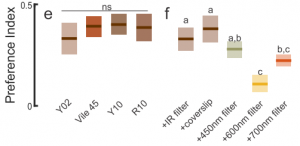You’re walking through the forest on a warm summer day, and you feel the familiar sting of a mosquito biting your arm. As you swat away the fly you notice a smattering of other bites you have accrued throughout your walk. I must taste sweet, you may think, postulating why you seem to be so popular among the mosquitoes today. While that may be true, a recent study proposed an alternate hypothesis for why and how mosquitoes may be attracted to human skin: our breath.
It is well documented that mosquitoes are visual creatures. Multiple studies have emphasized the importance of vision for mosquito flight, object tracking, and identifying hosts (humans and other animals). Much of this is mediated through wavelength identification. The colors we see every day are actually a compilation of wavelengths of light propagating at a specific frequency towards our eye. Different wavelengths correspond to different color perceptions, and there is data to suggest that certain odors stimulate attraction to certain wavelengths in mosquitoes.
Given this information, Alberto and colleagues postulated that the scent of CO2 may impact mosquitoes’ attraction to certain color wavelengths. To measure this, a specific species of mosquito (Ae. aegypti) was placed in a large wind tunnel equipped with various color swatches. Researchers then observed which hues mosquitoes preferred to fly near. Prior to the release of CO2 into the chamber, mosquitoes did not exhibit a preference for any particular color. However, after being exposed to the scent of CO2, mosquitoes exhibited a significant attraction towards colors with a wavelength between 510 and 660 nanometers. Interestingly, these wavelengths correspond to what we perceive as the colors of human skin.
To study this further, Alberto et al (2021) placed color swatches that represented the spectrum of human skin colors in the wind tunnel. These colors, demonstrated below, ranged from a pale tan to a dark brown and even included the artificial orange of a spray tan. Researchers also placed filters on some of the swatches which removed the wavelengths of light that correspond to skin color. In this way, mosquitoes would only be able to observe a portion of the frequencies reflected by the swatches, and thus may see different colors. As indicated by the figure below, mosquitoes exhibited a significant preference for the colors representing human skin (Y02, Vile 45, Y10, R10) following CO2 scent exposure. This preference was reduced when the filters were applied (450nm filter, 600nm filter, 700nm filter).

The results of this study have implications beyond avoiding the discomfort of itchy bug bites. While bug spray companies may be able to use this information to sell CO2 masking sprays for your next camping trip, more importantly this study provides valuable information for mediating the spread of infectious diseases. Mosquitoes are carriers of a multitude of blood borne illnesses such as malaria, zika, and dengue. While contraction of these diseases in higher income countries is rare, they are a leading cause of death in many developing regions. Understanding this link between CO2 scent and skin color attraction could improve the manufacturing of mosquito traps or protection. Thus, the results of this paper can inform prevention efforts and, in the process, potentially save lives.
Reference:
Alonso San Alberto, D., Rusch, C., Zhan, Y. et al. The olfactory gating of visual preferences to human skin and visible spectra in mosquitoes. Nat Commun 13, 555 (2022). https://doi.org/10.1038/s41467-022-28195-x
